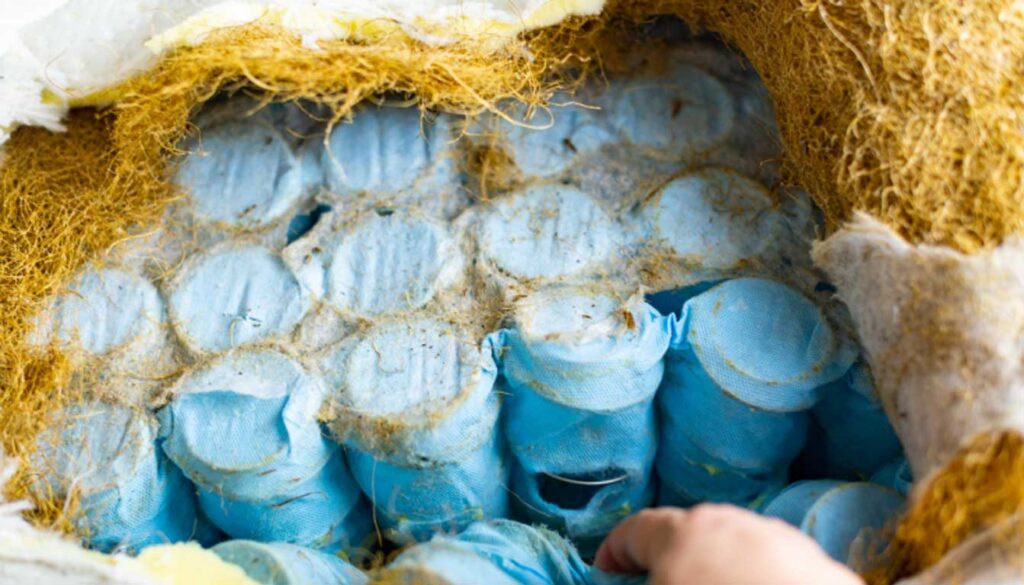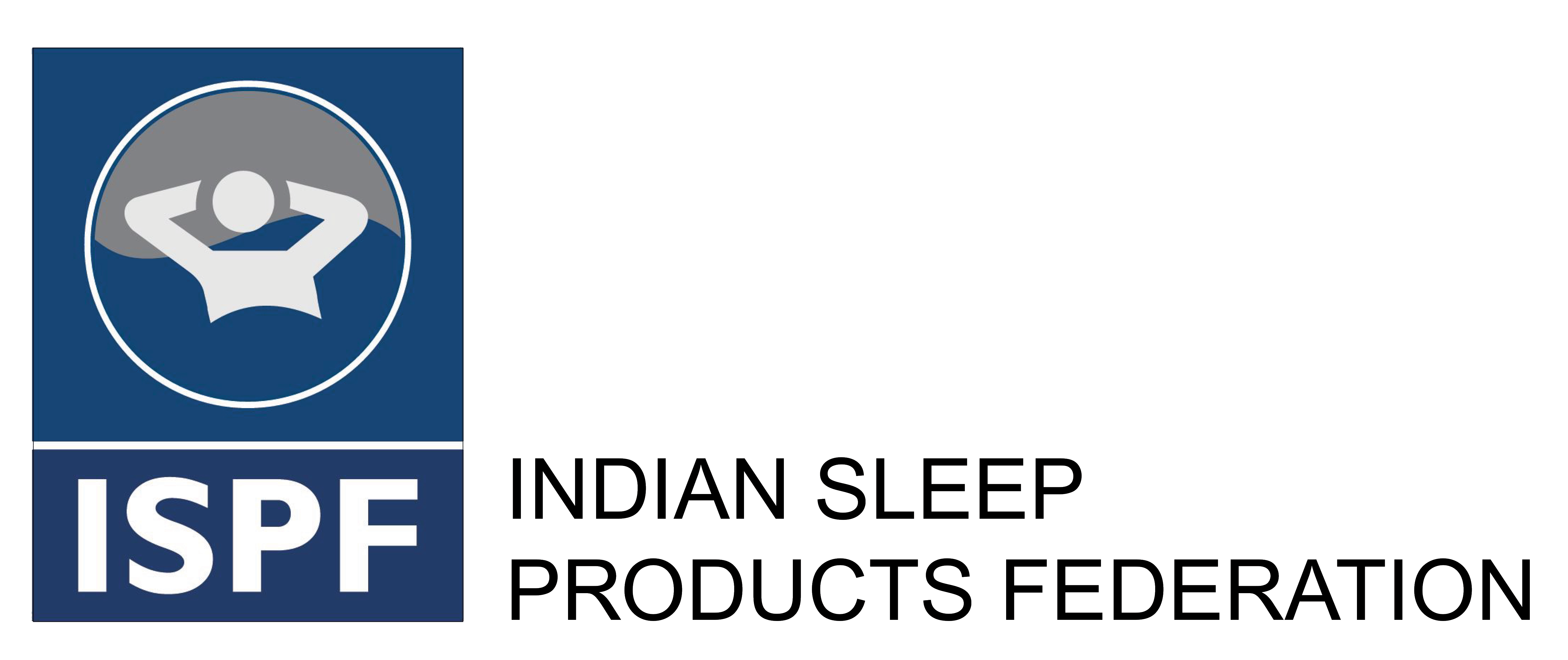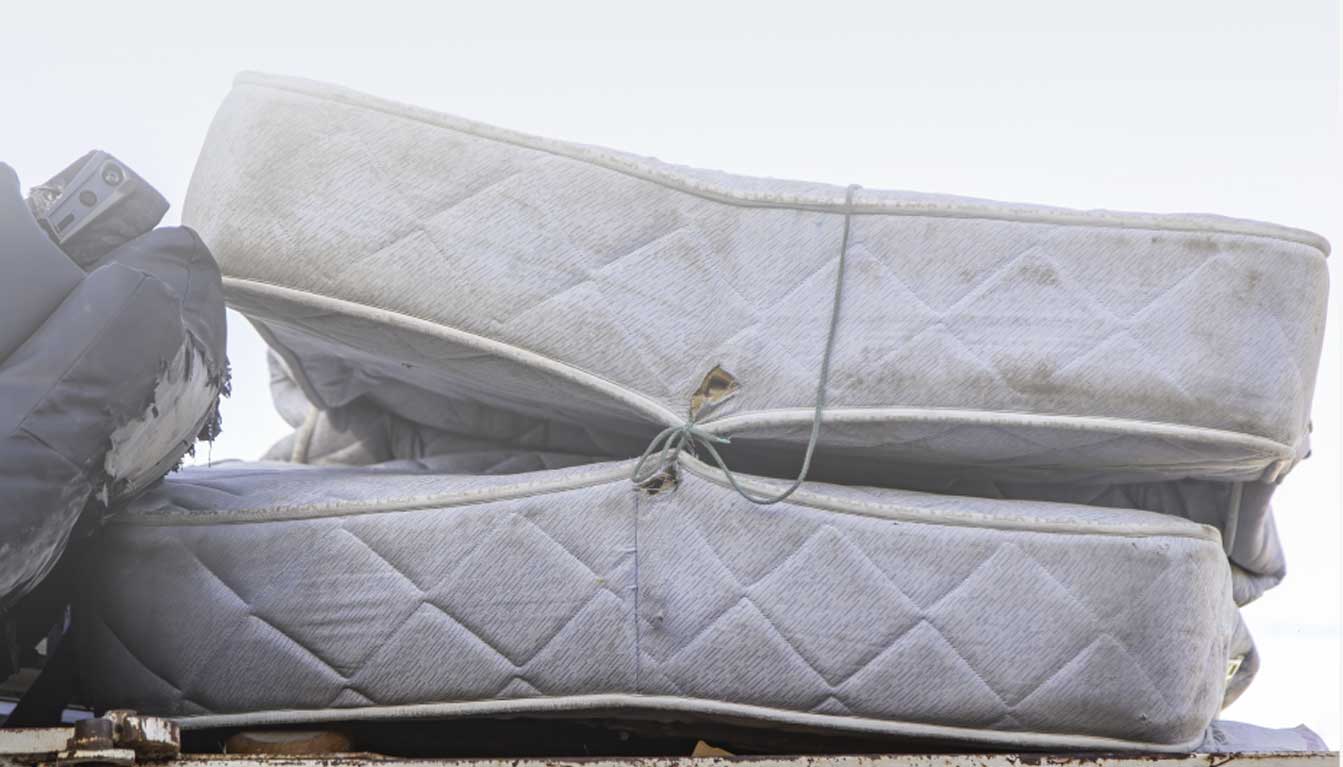What is interesting to note is that while other industries are still finding ways to achieve sustainability, the mattress industry has already started taking proactive measures and the humble mattress is trying to become one of the most unlikely contributor to this green revolution. Yes! You would be surprised to know that traditionally destined for landfills after their lifespan ends, used mattresses are now being proposed to be used in innovative ways. Well, a recent study states that mattress waste can now be used as sustainable building insulation material. Sounds interesting, right?
The growing mattress waste problem worldwide
Every year, millions of mattresses are discarded globally. This is because they are considered to be of no use and hence, occupy the landfill spaces. It is believed that a single mattress containing non-biodegradable materials such as Polyurethane Foam (PUF), metal springs, and synthetic fibers, can occupy up to 40 cubic feet of landfill space. There is no doubt that these materials take decades to break down, thus creating environment issues. So, since the environmental cost of this waste is considerable, there is growing need for more circular approach for mattress disposal.
Turning trash into thermal treasure
Innovation is driving the change in the mattress waste disposal domain. Few studies have shown that the mattress waste, particularly the foam, fabric and fiberfill components, could be used be used as high-performance insulation material. Particularly, PUF which is commonly used in mattresses for comfort layers, has shown excellent thermal resistance (high R-value), making it an effective insulator for walls, roofs and floors.
Well, a recent research showcased just such an innovation i.e., repurposing mattress waste, particularly PUF as an effective and sustainable building insulation material. With players like Kurlon and Sleepwell taking part in the research and contributing to the raw material mix, this research has been gaining both academic and industrial attention.
Mayank Sharma, Business Head Hospitality, Premium Segment, King Coil-India, notes, “There are not many companies in India that are there into mattress recycling domain. On top of it, this is a very new concept. Till date, foam was majorly recycled only to be used in the mattress again. Now, using PUF as building insulation material is something different. Lot of experiments need to be done on this front. Even awareness has to be created. There is still a long way to go on the mattress recycling front.”
Turning trash into thermal treasure
While not only the mattress industry produces a lot of waste, one of the other industries worldwide that consumes a lot of energy and is a significant contributor to the global waste generation is the building and construction industry. In order to promote sustainability in this sector as well as mattress industry and to address the dual challenge of resource consumption and effective waste management in the construction sector, a study was conducted.
The study began with a bibliometric analysis of 2,627 publications to identify waste materials being repurposed as insulation in construction systems. The findings clearly revealed that the mattress waste materials have been largely overlooked in this context. With the motive of addressing this gap, this research investigated the potential of repurposing discarded mattress components specifically recycled PUF as insulation material in buildings. While numerous waste-derived materials have found applications in construction till date, this study highlighted the unique potential of PUF sourced from the waste mattresses. To assess its suitability, a Transient Plane Source (TPS) technique was used to measure the thermal conductivity of mattress-derived PUF, collected from a recycling facility in Victoria, Australia and the results demonstrated encouraging thermal resistance.
The study benchmarked the material’s insulation properties against conventional building insulation standards and found that PUF, when properly processed, offered comparable thermal resistance, making it a viable alternative to traditional insulation options.
- The test samples used in the study comprised a material mix of:
- 25 per cent natural product sourced from Kurlon
- 25 per cent recycled product derived from Sleepwell mattresses
Creating a hybrid insulation board, this combination balanced sustainability with structural and thermal integrity. However, the study stated that more research is required to understand the material’s performance in terms of moisture resistance and fire retardancy.
A note on PUF as sustainable building insulation material
It is the most commonly used component in the modern mattresses and used for comfort and support layers. In closed-cell form, it is highly valued for its thermal insulation
properties. It is also lightweight and flexible. However, since it is highly flammable material, the use of PUF may be limited in construction. In fact, when burned, it can relase various
toxic gases like hydrogen cyanide and isocyanates, both of which can lead to various serious health and safety concerns. However, the usage of eco-friendly flame-retardant additives can help in mitigating these fire-related risks, and this can positively impact the commercial viability of recycled PUF. In fact, by using polymer-based flame-retardant compounds without causing significant alterations to the foam’s cellular structure, the health hazards of PUF can be reduced. As a result, the desirable physical and thermal insulation properties of PUF could be easily preserved for use in sustainable building applications.
Various other studies suggest that when combined with textile waste such as polyester or cotton fibers, recycled PUF (particularly from mattresses), can greatly enhance both its thermal and acoustic properties. There is no doubt that while directly applying mattress-derived PUF as an insulation material presents a promising sustainable solution, but further material engineering seems definitely essential to ensure it meets or exceeds the performance of conventional insulation products. In order to get the desired results, advanced blending techniques involving polymer waste mechanics can be adopted. This technically includes processing PUF into flakes, granules or powder, which can then be integrated into new composite insulation materials with tailored performance characteristics.
Other mattress waste materials for sustainable building construction
While the study focused primarily on PUF, there are various other waste mattress materials that can be used for sustainable construction. These include:
- Memory foam : It is found in the premium and orthopedic mattresses and is proved for its pressure relieving properties. It may look like PUF, but it is denser and offers slightly better sound insulation properties in combination with thermal benefits. Its main advantages include noise reduction due to dense structure and good compressive strength for padding or layering. However, one of the major challenges associated with it is that it can emit Volatile Organic Compounds (VOCs) and is less breathable that can affect the moisture regulation.
- Latex foam : It is derived from natural or synthesized rubber and is majorly used in the eco-friendly or luxury mattresses. It offers natural insulation and durability because of which it can be used in construction. If treated correctly, it could be efficiently used for floor underlays, wall panels or sound-dampening applications. Its main advantages are that it is biodegradable (if it is natural) and naturally resistant to mold and dust mites. The basic challenge with it is that it is costly and there might be limited supply from post-consumer waste sources.
- Fiber fill (polyester, cotton and wool) : It is commonly found in pillows and quilted layers of mattresses. These materials have strong acoustic absorption capabilities as they are soft and fibrous and can be blended with foams to improve both thermal and sound insulation. They are excellent for reducing ambient noise and can be compressed into panels. However, they require binding agents to form stable insulation panels. Also, their cleaning and sterilization is also a task but very essential.
- Coconut coir : It is made from coconut husk fibers and used in natural and orthopedic mattresses. Coir is a natural thermal and acoustic insulator and can be used in eco-friendly wall panels or as an underlayment. The low thermal conductivity of coir can help maintain stable temperatures, trapping warmth in winters and keeping interiors cool in summer. What more? Coir’s biodegradable and sustainable nature makes it a very environment friendly option as compared to other synthetic insulation materials. Also, it is moisture and pest-resistant. Srinivasan Sundaerasan, Secretary, ISPF, avers, “Coir fabric from mattresses can serve as a very good building insulation material due to its natural insulating properties, eco-friendly nature and durability.” The main challenge with it is that it is naturally brittle and may need to be combined with other binders or resins to be reused in construction industry.
- Metal springs : These are found in innerspring and hybrid mattresses. They can be repurposed in structural applications or recycled as scrap metal for use in steel products. The best part is that they are 100 per cent recyclable and can be used in rebar or structural fill, but they require energy-intensive separation process which might make them costly.
- Mattress fabric covers : They form the outer layer of mattresses and are typically polyester or blended fabrics. Shredded or bonded fabric scraps can serve as fillers in insulation composites or acoustic panels. However, since fabric covers are often composed of mixed fibers, they are difficult to recycle uniformly and must be cleaned properly.
Benefits of using mattress waste for building insulation
- Ensures sustainability : Reusing the old mattresses reduces landfill burden and contributes to a circular economy which means that it diverts waste while reducing the demand for virgin insulation materials at the same time.
- Promotes energy efficiency : It is seen that the foam-based insulation improves energy retention in buildings, reducing heating and cooling needs and lowering carbon footprints.
- Serves as cost-effective solution : There is no doubt that the recycled insulation materials are cheaper than traditional alternatives. Hence, they offer an affordable solution for green construction projects.
- Offer fire resistance : When treated with fire retardants, many mattress foams become safer for use in building applications.
- Leads to reduction in noise : When used as insulation in walls and ceilings, the fibrous materials from mattresses also offer soundproofing benefits.
Challenges and points to be considered
While the idea of using mattress waste as building insulation material looks promising, it is not that easy and there are many challenges associated with it. Here is a look at them.
- Separation and processing of different materials : Mattresses are highly complex products. They are made by combining different materials which are either glued or sewn together. These materials need to be separated carefully and that is challenging. Typically efficient separation and cleaning are crucial before repurposing the mattress waste.
- Health and safety is a concern : There is no doubt that the used mattresses harbor bacteria, mold or pests. So, proper sterilization and quality control are necessary to ensure safe reuse of the mattress waste.
- Standardization is difficult : Building materials need to meet the quality standards. Same goes with the mattress waste, if used as an insulation material. So, building codes and material standards need to accommodate recycled materials, which may demand further research and regulations.

Current scenario
The idea of using mattress waste as the sustainable building insulation material is still at infancy stage in India as well as abroad. The concept is very new and only few countries have started work on this front and amongst them is Europe and North America. In these two nations, some the recycling facilities have started converting mattress foam into insulation panels. As for India, where the whole concept of mattress recycling is still in its infancy, the idea of using mattress waste as building insulation material will take time to sink in. However, some startups and research institutions are showing interest and exploring the scalable models to harness this potential. Some pilot programs in sustainable housing and low-cost construction are beginning to test these materials for rural and urban applications alike.
Sundaerasan notes, “Gradually, steps are being taken on the mattress recycling front in India. Spring, coir and foam from mattresses are being reused and recycled to either create mattresses or other products. However, this idea of using the mattress waste as building insulation is very new for India.”
The way forward for India
At a time when India is grappling with a growing environmental concern that is mattress waste, using this waste as building insulation material is a smart solution and seems a very practical innovation.
If we go by the facts, then approximately 7 to 9 million mattresses are sold annually and the typical replacement cycle is of about 12 years. While this shows a good growth, the problem is that a similar number of mattresses are discarded each year. This leads to a lot of mattress waste and improper waste disposal can lead to these heavy items occupying significant landfill space and emitting toxic chemicals into the soil and groundwater. So, undoubtedly, proper recycling of mattress waste is essential. However, India currently lacks a comprehensive mattress recycling infrastructure. While some informal sectors, such as local scrap dealers are dismantling mattresses to get materials out of it that they can sell, this approach is unorganised and insufficient to address the scale of the problem. To combat this issue, organisations such as the Indian Polyurethane Association (IPUA), Indian Sleep Product Federation (ISPF) and the Kabadiwala have launched initialtives like the ‘Mattress Circular Journey’ campaign. In this line, the recent research on using mattress waste as sustainable building insulation material can give a very good boost to the ‘Mattress Circular Journey’ campaign.

This concept of mattress waste reuse presents an exciting opportunity to reduce the landfill load while contributing to more sustainable building practices. In fact, during the times when construction industry is seeking greener alternatives and the mattress industry is looking to reduce its waste problem, this solution is a win-win opportunity for both the industries. With this approach, both the industries can successfully achieve their sustainability goals.
To sum up, in the future, more investments in recycling infrastructure and safety standards could make the discarded mattresses the primary building blocks of a more sustainable future. However, since the approach is very different and demands new set of knowledge, practice and approach, efforts need to be taken to spread awareness. In fact, till date, in India and even worldwide, in the name of sustainability, primarily the focus was only on using recycled and organic materials for manufacturing the mattress. So, this research is only going to open new gates of opportunities.


